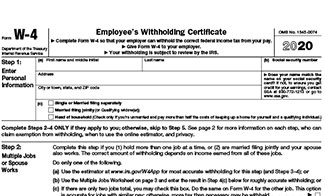New Form W-4 : What Employers Need to Know
After Congress passed the Tax Cuts and Jobs Act (TCJA) in 2017, the Internal Revenue Service moved quickly to publish new withholding tables that reflected the revamped tax rates. Unfortunately, redesigning the basic withholding form for employees’ use took considerably longer.
That situation has now been resolved, with the IRS’s release of the new 2020 Form W-4, Employee’s Withholding Allowance Certificate. Use of the new form is mandatory for all employees hired after Dec. 31, 2019 and for any previously hired employees who wish to adjust their withholding.
Note, however, that existing employees who do not want to make any withholding changes are not required to complete a new 2020 Form W-4 merely because of the redesign. Because the 2020 form takes a fundamentally different approach to calculating withholding, this means many employers will need to update their payroll systems in order to use inputs from both the new form and forms from prior years.
In addition to doing away with obsolete questions about allowances and personal exemptions, the new Form W-4 provides several ways for taxpayers to determine the appropriate withholding amounts. One method, a new online Tax Withholding Estimator, lets taxpayers perform a detailed review of their income and withholding.
Paper-based worksheets are still available too, but for maximum accuracy, the IRS encourages all taxpayers to use the new online tool to perform a “paycheck checkup.” It is located at https://www.irs.gov/individuals/tax-withholding-estimator.
As an employer, you should not question or adjust employees’ input on Form W-4. You might provide some general guidance, but steer clear of giving specific withholding advice or instructions. Instead, refer employees to their own tax advisor or to the IRS website.
